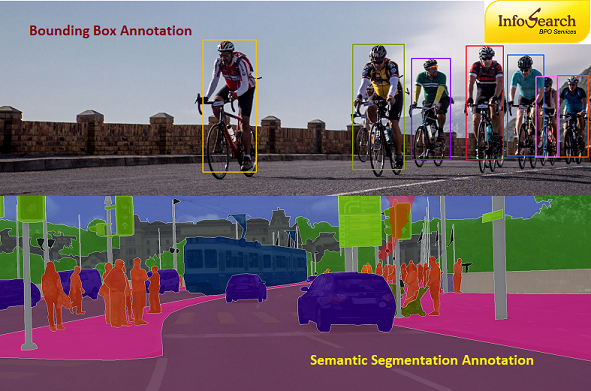
Deciding between bounding box annotation or semantic segmentation annotation is dependent on the task specificities, the level of abstraction needed and on the available resources. Infosearch provides both bounding box annotation and semantic segmentation annotation services and of course many other annotation types of annotation services. As this article talks about bounding box and semantic segmentation, you can count on Infosearch for outsourcing these annotation services. We serve almost every industry and help them for machine learning and computer vision. Contact Infosearch for your annotation requirements.
Here’s a comparison to help you choose the right annotation method:
Bounding Box Annotation:
1. Simplicity: The easier and quicker bounding box annotation is than the semantic segmentation. The annotation process is simple as human annotators only have to highlight objects with a rectangle, thereby spending less effort.
2. Object Localization: The bounding boxes let to have more accurate positioning of objects by placing them in a rectangular area. Thus, this technique is used to efficiently pinpoint items of interest in the image. This reveals that bounding boxes are applicable in cases where object localization is vital, for example, object detection and tracking.
3. Less Detailed: There is a discrepancy in the fine-tuned details that are ignored in bounding boxes and that are provided by semantic segmentation. They just act as a “glue” between regions of objects and can only uncover structural information of the objects when they are opened, which can only be used for some applications, for others, more detailed analysis is needed.
4. Class-Agnostic: Bounding boxes are class-agnostic, which means they do not provide any information about the type of object that is enclosed in them. Supplemental metadata is an inevitable need in order to demonstrate the class of each pertained bounding box, which is an additional and quite significant task during the anchoring process.
Semantic Segmentation:
1. Detailed Object Boundaries: Semantic segmentation detects precisely where the object exists and applies the labels pixel by pixel so as to preserve its appearance and internal structure. This information is a great help for, say, instance segmentation, where the separation of objects is required.
2. Object Identification: Semantic segmentation, in its direct representation, allots a label for each pixel pertaining to the object class in the image. This gives additional accuracy to failures where the optimal identification of objects and semantic context is crucial.
3. Resource-Intensive: Semantic segmentation is more time-consuming and resource-intensive than bounding box annotation as the annotation of each pixel in the image is done individually by annotators. This may demand for tool designed for the purpose by an expert team for more accuracy.
4. Semantic Context: Besides, semantic segmentation includes not only the object being in the scene but also their spatial location and semantic relations. This more complete representation can be helpful in tasks like image understanding where background information counts a lot.
Choosing the Right Method:
– Task Requirements: Paramount prerogative is analyzing your demands of the assignment. If extra-precise target object localization and tracking are required, bounding box annotation could be utilized. In case, you want detailed object boundaries and semantic context, then semantic segmentation is the way to go.
– Available Resources: Assess what you have got, by considering time, money, and the available ways of annotation. In case you have limited resources needed to implement faster annotation process, then the bounding box annotation is a better choice. If you can increase the resources and make the annotations finer-grained, semantic segmentation is the way to go.
– Application Domain: The domains of application should be considered and the depth of analysis to be done should be worked out. Semantic segmentation will replace bounding box annotation for some applications thanks to its data-rich output. Others will find themselves satisfactorily using a bounding box approach. In the end, the decision between bounding box annotation and semantic segmentation is about the level of detail needed, the available resources and the particular application or task requirements.
Contact Infosearch for bounding box annotation, semantic segmentation and more other annotation services.








Recent Comments